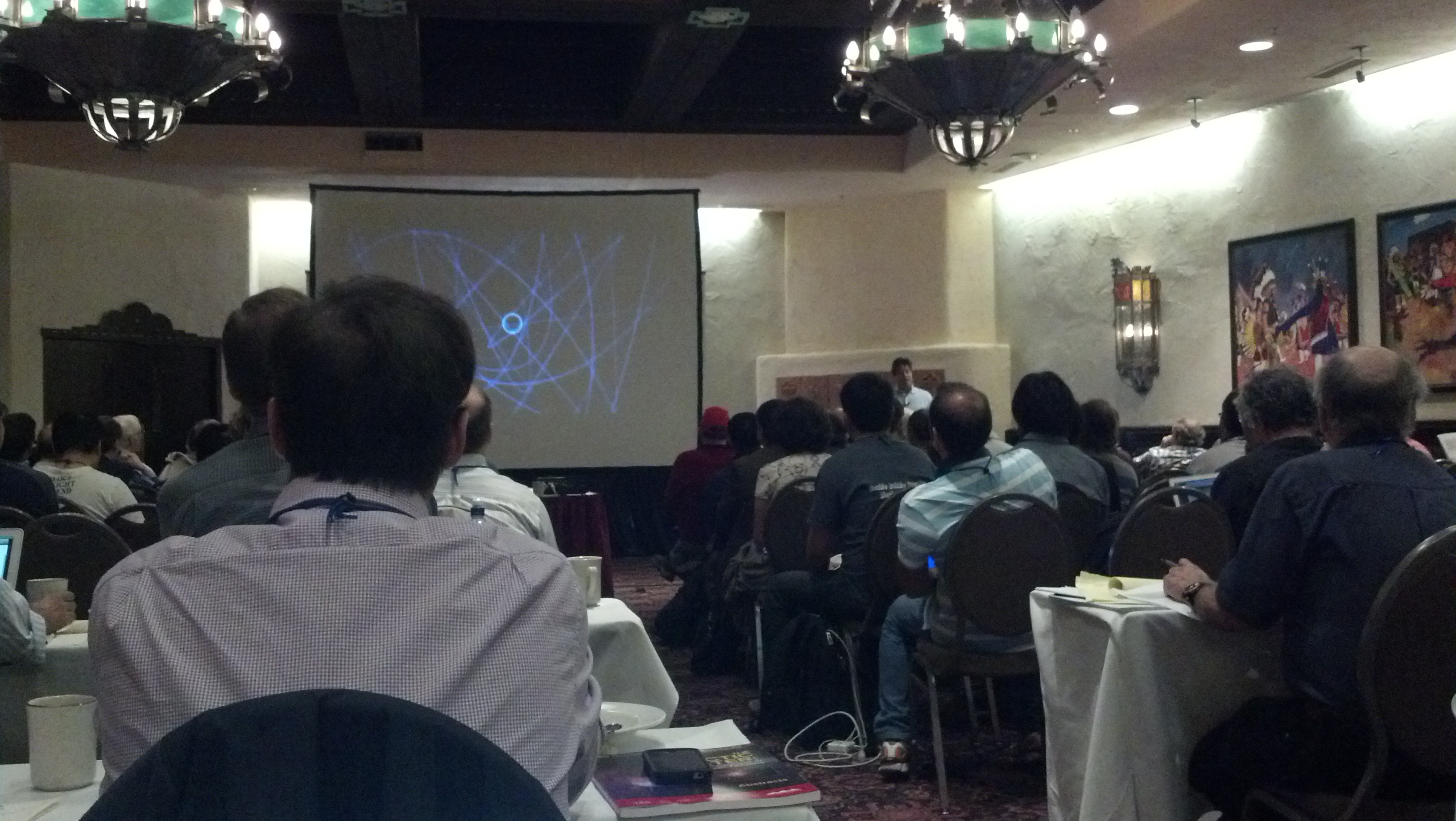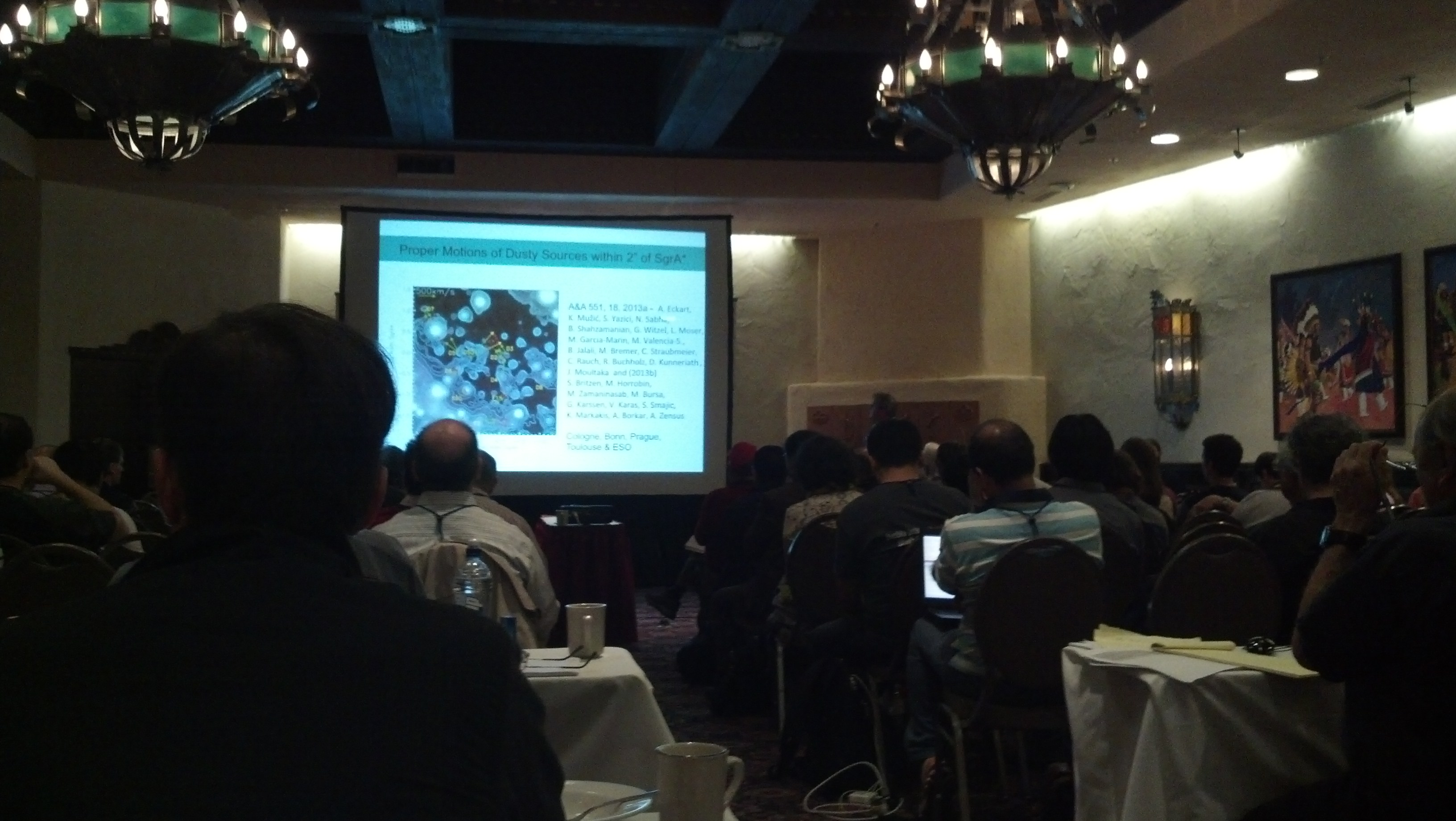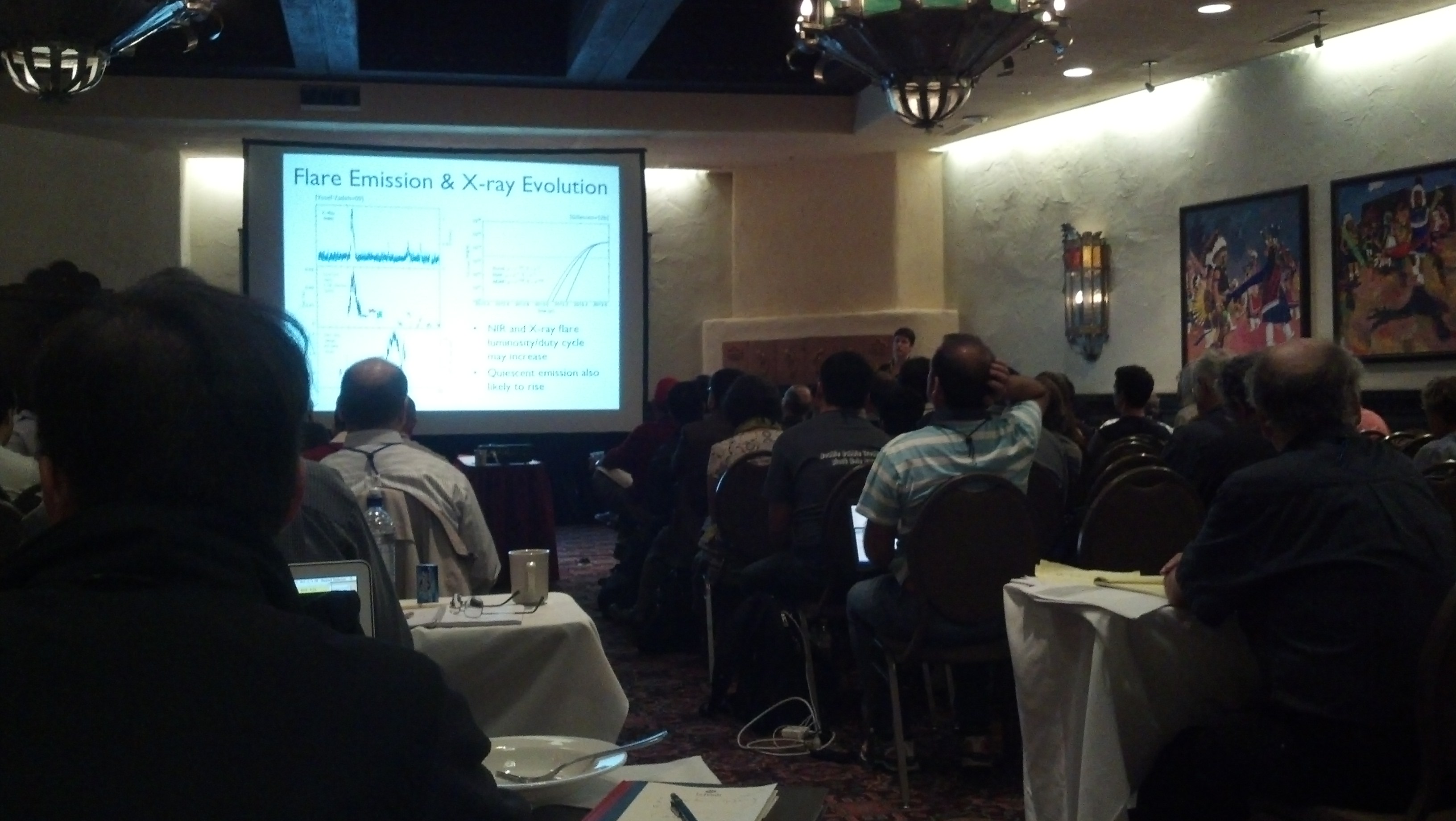9:00-9:30 am Stefan Gillessen (Germany): Overview Talk Observations of the G2 Cloud at SgrA* (25 + 5 minutes)

- Summary of measurements...
Mass of BH known "better than your own mass"
SINFONI data
ALMA cycle 0 data misses G2 b/c of redshift
date, location of periapse uncertain by ~months, factor of 2 in radii + radius ~100 AU + optically thin + ionized + 3 earth masses + density 10^5
PaA detected! redshifted into visible band
PV-diagram evolution with SINFONI
Some gas has passed pericenter + pericenter is prolonged - 1 yr
no x-ray heating detected yet
rotation measure still constant
wiki page for project idea: MPE wiki
Where does it come from? + wind interaction creating clumps?
- S91, IRS16SW have winds that could do it
- infalling jet material?
- form not at apocenter, but halfway in at high velocity
Proplyd? + predicted rising flux; this didn't happen
T Tauri star?
Star inside? + so far, evidence says no + gas is not presently bound
Sgr A* flares nightly
Questions
- Q: current velocity inconsistent with current model
- A: Maybe internal velocity has changed. Some gas on other side. Maybe things have changed now that there is no longer a single source
- Q Farhard: Estimate of density of sheared gas when on opposite side from the BrG?
- A: Haven't done that yet. Evolution is mostly radial (line-of-sight)
- Q Bally: Will the trailing gas continue to fall in? What is it?
- A: It is there, orbital motion slow, but close to overall BrG emission and confused with ambient. 20 years to infall
- Q: Are B-fields dynamically important?
- A: Talk tomorrow - various scenarios, possible that magnetized. Don't think we will see directly.
- Q: Predicting X-ray flares. Can you determine how much mass infalls?
- A: Not an easily invertible problem.
- Q Fred Lo: Infall of cloud to 1000 schwarzchild radii. Can you say anything about interior?
- A: Can't see anything yet. Should theoretically be "sea" of NS, BH around SMBH. Maybe will intersect?
- Q Mitch: If star in center, what limits on wind speed?
- A: First observations were unresolved. Rather low wind speed, 50-100 km/s
9:30-9:50 am Leo Meyer (USA): Keck Observations of G2 and SgrA (15 + 5 minutes)

- Agree on some things:
- red source
- evolving FWHM
- tidal interaction
- eccentric orbit
- Uncertainties:
- How much gas is there?
- compact gas cloud? How survived in the environment?
- Or is it a star?
- Will it have observable impact on Sgr A*'s emission
- 2013 data
- doesn't change anything
- BrG for radial vel and proper motion + bias in L' phot
- so far purely keplerian orbit + why would a gas cloud follow keplerian?
- slight changes to orbital parameters, mostly because of reference frame
- G2 tail
- PV diagram criticism: doesn't show spatial association
- tail not on the orbit
- claim that there is unassociated, independent gas
- Blueshifted emission
- wrong location?
- Residual of SO2?
- may not be what is seen in SINFONI data
- G2 not unique
- ~5 sources clearly seen
- [but G2 is the only one with high velocity]
- Sgr A* brightness
- currently as faint as ever seen
- new "hidden markov" model
- Sgr A* has only one state
Questions
- Q: Can you predict rate of G2-like interactions?
- A: No, but they don't explain flaring. 1-2 every 20 years?
- Q: New inclination angle closer to 90. Maybe more extended in radial direction.
- Q: Spectrum of G1?
- A: not ready to show yet
- Q: Caution about position-velocity diagram. If disrupted, shouldn't be keplerian in all pieces.
- A: it's the slit width in the PV diagram that's a problem
- Q: State transitions - can you incorporate multiwavelength data?
- A: "very general" model. Needs to be calibrated for other wavelengths
9:50-10:10 am Andreas Eckart (Germany): The infrared K-band identification of the DSO/G2 source from VLT and Keck data (15 + 5 minutes)

- Proper motions of "dusty sources"
- K-band detection of G2 cloud
- prior to 2008, confused with S63
- Possibilities for "DSO" = G2
- externally heated + expect extended dust emission + not observed
- internally heated + expect compact K-band (observed) + requires internal heating source: star
- massive star possible
- accretion of material?
- "Tail emission" part of background?
- interacting disk models suggest tail is part of interacting disks
- X3, X7 clouds...
- Where from? + compact clouds in CND + clouds collide -> high eccentricity infall + compression -> star formation + "beads" of stars falling in...
Questions
- Q: Extension of 0.2" in BrG. 20mas from Gillessen?
- A: Extended emission is from the tail
- Q: Movie - how possible to form stars at the close approach because of the short timescale of SF
- A: Orbital compression
- Q: Compressing gas - does that inhibit other SF? Prevent continuous SF?
- A: Short event... this model ongoing sf at lower level.... IRS13N young objects
- Q: Jupiter-like object?
- A: couple Lsun - 20-30 Lsun, points towards more massive object than a Jupiter
- Q Bally: Gas densities in simulation?
- A: intial density of clump n~10^5. Look at poster
- Q Ghez comment: analysis of images, not real data...
- A: Data downloaded from Keck archive
- Ghez: see anna bailey's poster, which shows technique for getting limits. We don't see G2.
- A: We see 19th magnitude "DSO"
10:10-10:30 am Darryl Haggard (USA): G2 as a Probe of Sgr A*'s Hot Environs: A View from Chandra and JVLA (15 + 5 minutes)

- Predicted possible x-ray emission
- multi-PI Chandra campaign
- X-ray view of CMZ: magnetar next to Sgr A* + confusion, overlapping PSFs + multi-hit issues (pile-up)
- no hints of G2 in X-ray
- one crazy bright flare
- magnetar can be used to probe LOS to Sgr A*
- simultaneous Chandra/VLA
Questions
- Q: VLA obs over past year. No evidence for flux density of Sgr A*. No bow shock emission.
- Q: Column density estimates. Associated with flare? Associated with Sgr A*? LOS?
- A: Conflation
- Q: Can you explain emission with single age (?)
- A: Separate fits are statistically equivalent
10:30-11:00 am Coffee Break
11:00-11:25 am Gunther Witzel (USA): IR observations and variability of SgrA* (20 + 5 minutes)
- NIR var Sgr A*
- NIR spectral index...
- Power law distribution of brightness...
- time behavior, structure function of spectral indices
- Break in PSD + 150, 500 minute break points
- simultaneous observations in L and H band + time-resolved measurements of spectral index + Very constant spectral index across all simultaneous measurements
Questions
- Q: Can you combine VLT and Keck data to extend a night?
- A: I've tried that....
- Q: Red curve below black, black below red on some plots. What's happening to the spectral index?
- A: spectral index variations are significant. Small compared to... other publications
- C: Amazing how constant spectral index is
11:25-11:45 pm Banafsheh Shahzamanian (Germany): NIR polarized observations of Sagittarius A* (15 + 5 minutes)
- NACO polarization measurements
- Sgr A* highly polarized
- Polarized flux density has lognormal + power-law distr.
- polarization and total flux density (weakly) anticorrelated + adding noise flattens correlation + confirms real... >3-sigma detection
- theory: depolarization at high flux comes from relativistic boosting
Questions
- Q: How does anticorrelation fit with the explanation of high-flux -> high pol?
- A: Highly polarized flux is from bright flares at high total flux densities
- [I didn't understand]
- Q Fred Lo: Any idea what radius flares are coming from?
- A: 6 Schwarzchild radii in the model
- Q: What constraints?
- A: (from audience) variability timescale
- Q: Is there a preferred vector position angle?
- A: ...?
- Q Sacha: Anticorrelation between "degree of correlation" and "flux" translates between polarized flux and total emission. We have interpreted as different components of an outflow, bright and high degree of polarization and faint with low degree of poln. Is this consistent?
- Q: 40-50% of time, flux is noise-dominated. Could there be noise-dominated state bias?
- A: We have tested by adding noise
- Q: Would individual flares track up and down the anticorrelation? Or is it only for large # of flares?
- A: only for composite.
- Q Mitch: What kind of correlation do you see related to position angle?
- A: Not included in our analysis
11:45-12:05 pm Kazunori Akiyama (Japan): Long-term monitoring of Sgr A* at 43GHz with VERA and KVN+VERA (15 + 5 minutes)
- Sgr A* with VLBI
- larger at lower frequencies
- variability correlated with spectral index
- single component for 3 years + size not correlated with radio flux
- flares come from component emerging from optically thick region?
- Flares with G2? + maybe detected bowshock?
- VERA shows consistent major axis size
- KVN + VERA: comparable to VLBA
Questions
- Q: Variation of intrinsic size with flux... difficult measurement to make. VLA+ALMA observations of radio flares requires relativistic...
- Q: HET hasn't passed 10% of material (??)
- Q: Size doesn't increase with flux. But that's interstellar scattering size. Could intrinsic size have changed by 10-15% without being detected?
- A: ???
- Q Fred Lo: intrinsic size measured. Any elongation/ellipticity?
- A: Just a 1-dimensional measurement
12:05-12:25 pm Salomé Dibi (Netherlands): Exploring plasma behavior around Sgr A*
- Sgr A* in context...
- only flaring AGN
- discussion of particle distrbution related to SED & state
- accretion flow injecting electrons into plasma
- nonthermal synchrotron with cooling break is best distribution
Questions
- Q Broderick: Should be able to produce both observed features of flares...
- A: Tried to reproduce spectral index. Flaring in infrared could provide strong constraints
- Q: Spectral index should evolve in your model, but we heard that it is not changing
- C: Radio spectrum has gone even lower... falls on power law, useful for modeling. Makes deviation even more severe.
- C: spectral index measurements - flares measured with spectral indices don't have X-ray counterparts. Maybe X-ray bright flares may have non-constant spectral indices.
- C: Fit within 2 R_G, so radio is not relevant (optically thick)
- Q Ostriker: 1-zone model. What is the geometry?
- Event close to BH.
12:25-12:45 pm Jim Moran (USA): History of High Resolution Imaging of SgrA* (15+5 min)
- History
- 1951 Cygnus A: resolved double
- looking for compact structure in HII regions with 35km Green Bank interferometer
- simple observation -> 0.1" size, 10^7K T_B
- OVRO group found HII regions, but searching for BH, Balick & Brown searching for HII and found SMBH + Fred Lo 3.7cm found Sgr A*, T_B ~ 10^8K, <0.02"
- Jodrell Bank -> size ~ freq^-2
- Fish et al: early 1.3mm VLBI + consistent with Gaussian or annulus
- annular radii not at all constrained by short baselines
Questions
- C Fred Lo: Explanation of series of events. Obstacle for detecting structure of Sgr A* is scattering.
- If you can characterize the Gaussian interstellar scattering, you could in principle deconvolve
- C Farhad: Variability of Sgr A* is a problem. 230 GHz has high, hourly variability
- Goal should be testing models on 10min timescales
Discussion Section
- We agree on some things: + source is infalling + L-band source + Br-G detected
- Controversy:
- K-band detection is controversial. Can we sort that out? If it's there, will it change interpretation a lot?
- K-band source would be compatible with hot dust. H-band is the real discriminator
- What is the source we detect? There are K-band sources, but their natures are unclear
- Extinction makes it extra hard
- Ghez: What is G2? Very similar to S-star orbits. Orbital characteristics of binary exchange. Perhaps just a close binary, soon to form an S-star? Tidally disrupt atmosphere, but be a star underneath
- Problem: star not that big. If it's a star, very cool star dominated by dust, difficult to detect.
- Closest approach is no closer than S-stars + orbit also matches disk
- Dusty, looks like an S-star + No, it is a GAS source, not a dust source. Gas is directly detected
- As it travels by Sgr A*, do I care if it has anything inside?
- Ghez: forces us to consider role of binaries at cmz
- Comment: wait and see what happens + What if nothing happens? Will that resolve the issue?
- Are we just seeing weather in Sgr A*? + eh, maybe?
- Are we agreeing on emission mechanism?
- continuously variable source. No quiescent vs flaring state in IR; more prominent in X-ray